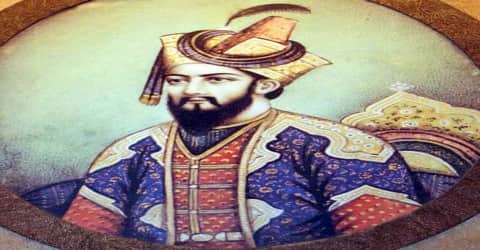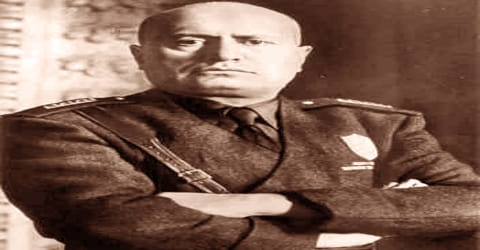Biography of Babur
Babur – First Emperor of the Mughal dynasty in the Indian subcontinent.
Name: Zahir-ud-din Muhammad Babur (ظهیرالدین محمد بابر)
Date of Birth: 14 February 1483
Place of Birth: Andijan, Timurid Empire (present-day Uzbekistan)
Date of Death: 30 December 1530 (aged 47)
Place of Death: Agra, Mughal Empire (present-day India)
Famous As: Founder of Mughal Dyanasty
Father: Umar Sheikh Mirza, ʿAmīr of Ferghana Valley
Mother: Qutlugh Nigar Khanum
Religion: Sunni Islam
Spouse: Aisha Sultan Begum, Dildar Begum, Gulnar Aghacha, Gulrukh Begum, Maham Begum, Masuma Sultān Begum, Mubarika Yusufzai, Nargul Agha Begum, Saliha Sultan Begum, Zaynab Sultān Begum
Children: Altun Bishik, Askari Mirza, Fakhr-Un-Nissa, Gulbadan Begum, Gulchehra Begum, Gulrang Begum, Hindal Mirza, Humayun, Kamran Mirza
Early Life
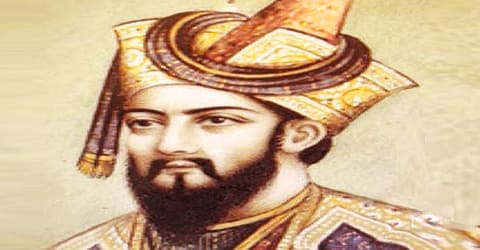
Babur was an Uzbek warrior who laid the foundation of the Mughal dynasty in the Indian subcontinent and became the first Mughal emperor. He was born on February 15, 1483, principality of Fergana (now in Uzbekistan). His birth name is Zahir ud-din Muhammad, BaBur being a nickname later granted and meaning “panther”.
Bābur came from the Barlas tribe of Mongol origin, but isolated members of the tribe considered themselves Turks in language and customs through long residence in Turkish regions. Hence, Bābur, though called a Mughal, drew most of his support from Turks, and the empire he founded was Turkish in character. His family had become members of the Chagatai clan, by which name they are known. He was fifth in male succession from Timur and 13th through the female line from Genghis Khan.
Babur was the eldest son of Umar Sheikh Mirza, governor of Fergana and great grandson of Timur the Great. He ascended the throne of Fergana in its capital Akhsikent in 1494 at the age of twelve and faced rebellion. He conquered Samarkand two years later, only to lose the vilayat of Fergana soon after. In his attempt to reconquer Fergana, he lost control of Samarkand. In 1501, his attempt to recapture both vilayats went in vain as he was defeated by Muhammad Shaybani Khan. In 1504, he conquered Kabul, which was under the rule of the infant heir of Ulugh Begh. Babur formed a partnership with Safavid ruler Ismail I and reconquered parts of Turkistan, including Samarkand, only to again lose it and the other newly conquered lands to the Sheybanids.
The First Battle of Panipat was the biggest battle that Babur fought. It started in April 1526 when Babur’s forces invaded the Lodi Empire in north India. This was one of the earliest battles involving gunpowder firearms and field artillery. The battle led to the death of Ibrahim Lodi and resulted in a decisive victory for Babur, enabling him to initiate the establishment of the Mughal Empire.
Babur ruled nearby Osh in Fergana Valley, located in modern Kyrgyzstan, pondered his future on Sulayman Mountain and even constructed a mosque atop of the mountain. Babur somehow concludes that the confines of the Fergana would cramp his aspirations as a descendant of famous conquering warrior princes. He wrote of the city:
“There are many sayings about the excellence of Osh. On the southeastern side of the Osh fortress is a well-proportioned mountain called Bara-Koh, where, on its summit, Sultan Mahmud Khan built a pavilion. Farther down, on a spur of the same mountain, I had a porticoed pavilion built in 902 (1496-7)”
A valiant warrior from a young age, he soon began embarking on military campaigns to expand his territories. However, during the course of his early campaigns, he lost control over the city of Fergana. But he did not let this early setback thwart his quest for power and formed a partnership with Safavid ruler Ismail I and re-conquered parts of central Asia. Eventually, he set his eyes upon the Indian subcontinent and attacked the Delhi Sultanate ruled by Ibrahim Lodi and defeated him at the First Battle of Panipat. This marked the beginning of the Mughal Empire in India. He soon faced opposition from Rana Sanga of Mewar who considered Babur as a foreigner and challenged him. Babur successfully defeated Rana at the Battle of Khanwa. In addition to being an ambitious ruler, he was also a gifted poet and a lover of nature.
The Battle of Khanwa, which was fought near the village of Khanwa, was another one of Babur’s major battles. Rajput ruler Rana Sanga considered Babur to be a foreigner and opposed his rule in India. Thus he decided to drive out Babur and extend his own territories by annexing Delhi and Agra. However, Rana’s plans failed miserably and his army was crushed by Babur’s forces.
Babur married several times. Notable among his sons are Humayun, Kamran Mirza, and Hindal Mirza. Babur died in 1530 and was succeeded by Humayun. According to Babur’s wishes, he was buried in Bagh-e Babur in Kabul, Afghanistan. Being a patrilineal descendant of Timur, Babur considered himself a Timurid and Chagatai Turkic. He is considered a national hero in Uzbekistan and Kyrgyzstan. Many of his poems also have become popular folk songs. He wrote Baburnama in Chaghatai Turkic and this was translated into Persian during Akbar’s reign.
Childhood, Family and Educational Life
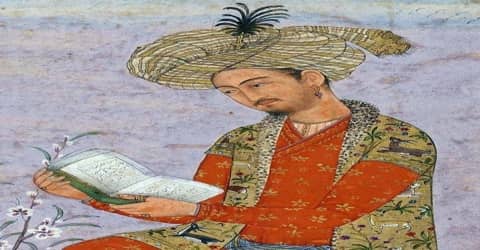
Bābur, (Persian: “Tiger”)also spelled Bābar or Bāber, original name Ẓahīr al-Dīn Muḥammad Babur, was born on 14 February 1483 in the city of Andijan, Andijan Province, Fergana Valley, contemporary Uzbekistan, as the eldest son of Umar Sheikh Mirza, ruler of the Fergana Valley, and his wife Qutlugh Nigar Khanum.
Ẓahīr-ud-Dīn is Arabic for “Defender of the Faith” (of Islam), and Muhammad honors the Islamic prophet. The difficulty of pronouncing the name for his Central Asian Turco-Mongol army may have been responsible for the greater popularity of his nickname Babur, also variously spelled Baber, Babar, and Bābor. The name is generally taken in reference to the Persian babr, meaning “tiger”. The word repeatedly appears in Ferdowsi’s Shahnameh and was borrowed into the Turkic languages of Central Asia. Thackston argues for an alternate derivation from the PIE word “beaver”, pointing to similarities between the pronunciation Bābor and the Russian bobr (бобр, “beaver”).
Babur bore the royal titles Badshah and al-ṣultānu ‘l-ʿazam wa ‘l-ḫāqān al-mukkarram pādshāh-e ġāzī. He and later Mughal emperors used the title of Mirza and gurkhan as regalia.
He is a direct descendant of Tamerlane by his father. Tamerlane was a 15th-century conqueror who acquired a large territory over western and eastern Asia. He was known for his ability to slaughter the inhabitants of the lands they occupied, making him one of the biggest killers the planet has ever known. Babur’s father was Omar Sheikh Mirza, king of Ferghana, a region presently in Uzbekistan. His mother was Kutlug Nigar Khanim, a descendant of Genghis Khan. As a result, Babur had an ancestry filled with warriors, yet he was a rather fine literate. He received a thorough education, developing the arts as literature. His language was Chagatai, an orientated version of Turkish, which he will use to write his memoirs. He was also an accomplished rider and a good swimmer.
Babur hailed from the Barlas tribe, which was of Mongol origin and had embraced Turkic and Persian culture. They had also converted to Islam centuries earlier and resided in Turkestan and Khorasan. Aside from the Chaghatai language, Babur was equally fluent in Persian, the lingua franca of the Timurid elite.
Hence, Babur, though nominally a Mongol (or Moghul in the Persian language), drew much of his support from the local Turkic and Iranian people of Central Asia, and his army was diverse in its ethnic makeup. It included Persians (known to Babur as “Sarts” and “Tajiks”), ethnic Afghans, Arabs, as well as Barlas and Chaghatayid Turko-Mongols from Central Asia.
Personal Life
There are no descriptions about Babur’s physical appearance, except the paintings in the translation of the Baburnama prepared during the reign of Akbar. Babur claimed to be strong and physically fit, and claimed to have swum across every major river he encountered, including twice across the Ganges River in North India. Unlike his father, he had ascetic tendencies and did not have any great interest in women.
Babur married several times. His first wife was Aisha Sultan Begum, his cousin, the daughter of Sultan Ahmad Mirza. He also married many other women and some of his well-known wives were Zaynab Sultan Begum, Maham Begum, Gulrukh Begum, and Dildar Begum. However, he acquired several more wives and concubines over the years, and as required for a prince, he was able to ensure the continuity of his line.
During his rule in Kabul, when there was a time of relative peace, Babur pursued his interests in literature, art, music, and gardening. Previously, he never drank alcohol and avoided it when he was in Herat. In Kabul, he first tasted it at the age of thirty. He then began to drink regularly, host wine parties and consume preparations made from opium. Though religion had a central place in his life, Babur also approvingly quoted a line of poetry by one of his contemporaries: “I am drunk, officer. Punish me when I am sober”. He quit drinking for health reasons before the Battle of Khanwa, just two years before his death, and demanded that his court do the same. But he did not stop chewing narcotic preparations and did not lose his sense of irony. He wrote, “Everyone regrets drinking and swears an oath (of abstinence); I swore the oath and regret that.”
Career and Works
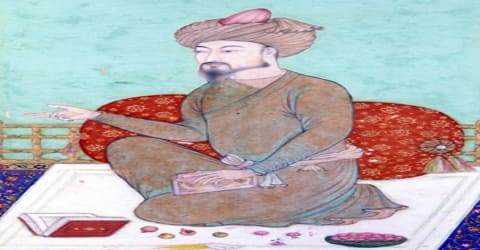
His father Omar died on June 8, 1494. At that time, in these regions, the rules of succession were not established in a clear way, it is beside the wars of succession which weakened the future moghul empire. After Omar’s death, his uncles tried to ascend the throne of Ferghana but they failed, his son Zahir having managed to grant it. He is only 12 years old.
Amidst the relentless attempts by his uncles to snatch away his throne, young Babur received great help from his maternal grandmother, Aisan Daulat Begum in his quest to retain his kingdom.
Babur proved to be an ambitious young man and nurtured a desire to capture the city of Samarkand to the west. He besieged Samarkand in 1497 and eventually gained control over it. He was just 15 at the time of this conquest. However, due to continued rebellions and conflicts, he lost control over Samarkand after just 100 days and also lost Fergana.
In 1501, Babur laid siege to Samarkand once more, but was soon defeated by his most formidable rival, Muhammad Shaybani, Khan of the Uzbeks. Samarkand, his lifelong obsession, was lost again. He tried to reclaim Fergana but lost it too and escaping with a small band of followers, he wandered to the mountains of central Asia and took refuge with hill tribes. Thus, during the ten years since becoming the ruler of Fergana, Babur suffered many short-lived victories and was without shelter and in exile, aided by friends and peasants. He finally stayed in Tashkent, which was ruled by his maternal uncle. Babur wrote, “During my stay in Tashkent, I endured much poverty and humiliation. No country, or hope of one!” For three years Babur concentrated on building up a strong army, recruiting widely amongst the Tajiks of Badakhshan in particular. By 1502, he had resigned all hopes of recovering Fergana; he was left with nothing and was forced to try his luck someplace else.
Having formed a small army he recovers his territory of Ferghana but in 1501 he is again hunted by the Uzbeks and their warlords Muhammad Shaybani. Only surrounded by a few dozen loyal warriors Babur will wander into his lost kingdom until 1504, when he reaches Kabul and seizes the city. But Kabul was a rich city, it is found at the head of a kingdom certe small, but prosperous.
He spent the next few years building a strong army and in 1504, he marched into the snow-bound Hindu Kush mountains into Afghanistan. He successfully besieged and conquered Kabul his first major victory. This helped him to establish a base for his new kingdom. By 1505 he had set his eyes upon conquering territories in India. However, it would take him several more years before he was able to build a formidable army and finally launch an attack on the Delhi Sultanate.
In 1504, Babur was able to cross the snowy Hindu Kush mountains and capture Kabul from the remaining Arghunids, who were forced to retreat to Kandahar. With this move, he gained a new kingdom, re-established his fortunes and would remain its ruler until 1526. In 1505, because of the low revenue generated by his new mountain kingdom, Babur began his first expedition to India; in his memoirs, he wrote, “My desire for Hindustan had been constant. It was in the month of Shaban, the Sun being in Aquarius, that we rode out of Kabul for Hindustan”. It was a brief raid across the Khyber Pass.
In the same year, Babur united with Sultan Husayn Mirza Bayqarah of Herat, a fellow Timurid, and distant relative, against their common enemy, the Uzbek Shaybani. However, this venture did not take place because Husayn Mirza died in 1506 and his two sons were reluctant to go to war. Babur instead stayed at Herat after being invited by the two Mirza brothers. It was then the cultural capital of the eastern Muslim world. Though he was disgusted by the vices and luxuries of the city, he marveled at the intellectual abundance there, which he stated was “filled with learned and matched men”. He became acquainted with the work of the Chagatai poet Mir Ali Shir Nava’i, who encouraged the use of Chagatai as a literary language. Nava’i’s proficiency with the language, which he is credited with founding, may have influenced Babur in his decision to use it for his memoirs. He spent two months there before being forced to leave because of diminishing resources; it later was overrun by Shaybani and the Mirzas fled.
Babur’s early relations with the Ottomans were poor because the Ottoman Sultan Selim I provided his rival Ubaydullah Khan with powerful matchlocks and cannons. In 1507, when ordered to accept Selim I as his rightful suzerain, Babur refused and gathered Qizilbash servicemen in order to counter the forces of Ubaydullah Khan during the Battle of Ghazdewan. In 1513, Selim I reconciled with Babur (fearing that he would join the Safavids), dispatched Ustad Ali Quli the artilleryman and Mustafa Rumi the matchlock marksman, and many other Ottoman Turks, in order to assist Babur in his conquests; this particular assistance proved to be the basis of future Mughal-Ottoman relations. From them, he also adopted the tactic of using matchlocks and cannons in the field (rather than only in sieges), which would give him an important advantage in India.
In 1510 his enemy Muhammad Shaybani died. Babur will then claim Ferghana. He will ally himself with the Turkmen to obtain an army and eventually take Samarkand again in 1511, but as the previous time, he is driven out the following year, defeated by the Uzbeks. He returned to Kabul in 1514 without having achieved his ends.
When Bābur made his first raid into India in 1519, the Punjab region (now divided between the Indian state and the Pakistani province) was part of the dominions of Sultan Ibrāhīm Lodī of Delhi, but the governor, Dawlat Khan Lodī, resented Ibrāhīm’s attempts to diminish his authority. By 1524 Bābur had invaded the Punjab three more times but was unable to master the tangled course of Punjab and Delhi politics sufficiently enough to achieve a firm foothold. Yet it was clear that the Delhi Sultanate was involved in contentious quarreling and ripe for overthrow. After mounting a full-scale attack there, Bābur was recalled by an Uzbek attack on his Kabul kingdom, but a joint request for help from ʿĀlam Khan, Ibrāhīm’s uncle, and Dawlat Khan encouraged Bābur to attempt his fifth, and first successful, raid.
Fearing the Uzbeks, on the western facade of his kingdom, he turned to the East and its region of Punjab, a region formerly a member of the Timurid Empire. Region rather rich, its annexation would be a good source of income for him and it would open to him the doors of India. So he sent several troops into Punjab to try to take Lahore, which he managed to do in 1523. Then, the next city, even more interesting, is Delhi, but it is directed by Lôdi, 3rd Sultanate Sultanate from Delhi, a hateful and hated character of all, including the local nobility, mostly Afghans. Burb, therefore, seized this opportunity and allied himself with a Punjab rebel leader, Alam Khan, who provided him with an army of 12,000 men.

(Mughal artillery and troops in action during the Battle of Panipat (1526))
Setting out in November 1525, Bābur met Ibrāhīm at Panipat, 50 miles (80 km) north of Delhi, on April 21, 1526. Bābur’s army was estimated at no more than 12,000, but they were seasoned followers, adept at cavalry tactics, and were aided by new artillery acquired from the Ottoman Turks. Ibrāhīm’s army was said to number 100,000 with 100 elephants, but its tactics were antiquated and it was dissentious. Bābur won the battle by coolness under fire, his use of artillery, and effective Turkish wheeling tactics on a divided, dispirited enemy. Ibrāhīm was killed in battle. With his usual speed, Bābur occupied Delhi three days later and reached Agra on May 4. His first action there was to lay out a garden, now known as the Ram Bagh, by the Yamuna (Jumna) River.
At the head of such an army, Babur walks on Delhi. Lôdi sends an army of 100,000 men and combat elephants. The two forces meet at Pânipat on April 21, 1526, the date of the great founding battle of the Mughal Empire. Lôdi’s troops are defeated and Babur takes Delhi in the wake with the help of his son Humâyûn. He then proclaims himself Emperor of India and continues his journey on Agra, which they conquer together.
The decisive victory in the First Battle of Panipat helped Babur in laying the foundation for the Mughal Empire. Following the battle, he occupied Delhi and Agra and set about consolidating his empire.
Babur then founds the foundations of a new empire and begins to structure his new territory, but the first enemy arrives quickly. It is Rana Sangha, from the city of Chittorgarh, in Rajasthan (west of India), which is based on Delhi in 1527. Rana Sanga was supported by Afghan chiefs in his opposition and fought bravely, but Babur went on to win the battle because of his superior generalship and use of modern warfare. A new battle took place on March 10 this year in Kanwaha and, despite the unbalanced balance of power in favor of Sangha, he lost the battle. Rajasthan falls into the purse of Babur. His thread Humâyûn pursues the conquest of the Ganges valley and pacifies the region.
Upon reaching Chanderi, on January 20, 1528, Babur offered Shamsabad to Medini Rao in exchange for Chanderi as a peace overture, but the offer was rejected. The outer fortress of Chanderi was taken by Babur’s army at night, and the next morning the upper fort was captured. Babur himself expressed surprise that the upper fort had fallen within an hour of the final assault. Medini Rai organized a Jauhar ceremony during which women and children within the fortress immolated themselves. A small number of soldiers also collected in Medini Rao’s house and proceeded to kill each other in collective suicide. This sacrifice does not seem to have impressed Babur who does not express a word of admiration for the enemy in his autobiography.
Bābur’s dominions were now secure from Kandahār to the borders of Bengal, with a southern limit marked by the Rajput desert and the forts of Ranthambhor, Gwalior, and Chanderi. Within that great area, however, there was no settled administration, only a congeries of quarreling chiefs. An empire had been gained but still had to be pacified and organized. It was thus a precarious heritage that Bābur passed on to his son Humāyūn.
In 1530, when Humāyūn became deathly ill, Bābur is said to have offered his life to God in exchange for Humāyūn’s, walking seven times around the bed to complete the vow. Humāyūn recovered and Bābur’s health declined, and Bābur died the same year.
Death and Legacy
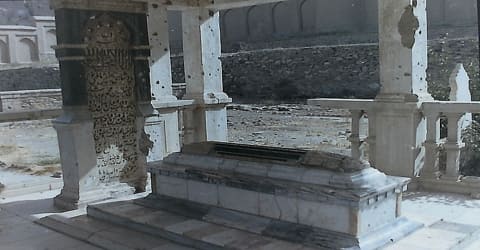
(Tombstone of Babur in Bagh-e Babur, Kabul, Afghanistan)
Babur suffered from ill health during the last years of his life. He died at the age of 47 on 5 January (O.S. 26 December 1530) 1531 and was succeeded by his eldest son, Humayun. After death, his body was moved to Kabul, where it lies in Bagh-e Babur.
It is generally agreed that, as a Timurid, Babur was not only significantly influenced by the Persian culture, but also that his empire gave rise to the expansion of the Persianate ethos in the Indian subcontinent.
The reign of Babur was rather short, only four years (1627-1630). During this period he respected local traditions and introduced various influences into the Indian subcontinent. For example, in architecture, the Timurid tradition dictates that the grounds for imperial constructions should be divided by canals and basins of great symmetrical rigor, which can be found in all the constructions of the dynasty. Such gardens, which are called here Charbagh, are generally in 4 parts, separated by 4 cross channels. They are a representation of Paradise on Earth, as is the Muslim tradition.
Babur is considered a national hero in Uzbekistan, and many of his poems have become popular Uzbek folk songs. In October 2005, Pakistan developed the Babur Cruise Missile, named in his honor.
Information Source:
